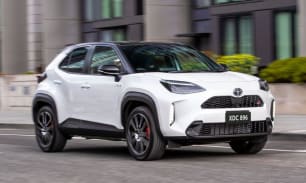We've driven every version of the Yaris Cross since its late 2020 launch in Australia, and without hesitation, the GR Sport is the least impressive of an otherwise great range of small SUVs.
And nowhere is that more evident than in the way it behaves around town.
As its creators intended, the Yaris Cross was born to be an urbanite. Lofty seating, good visibility, zippy acceleration, strong brakes, a tight turning circle and – in the base GX and mid-spec GXL on 16-inch wheels and tyres – a decent level of isolation from road bumps are key and very desirable attributes for city and suburban commuting.
Tick the hybrid box and the added electrical oomph and occasional silent running that electrification brings just add to the Toyota SUV's appeal in these circumstances.
Now, what you gain in style, stance and better tyre grip in the Urban, wearing the 18-inch wheels, you lose in ride comfort over bad roads due to an underlying firmness, and increased road noise intrusion over some coarse surfaces.
However, with its 10mm lower ride height and sports-tuned suspension, the GR Sport is firmer and louder again, and that detracts from its comfort and refinement.
Not to the degree that it's a deal-breaker, because the basics are still there and the Yaris Cross DNA remains, but there are marked differences between the grades.
If most of your driving is urban, you might want to rethink the GR Sport as a result unless the roads you commute on are smooth, because you'll barely notice the improved handling and body control at lower speeds that this grade specialises in.
Driving away onto rural roads, however, reveals a slightly more solid and focused handling machine, with quite direct (if not very tactile) steering through fast tight turns, accompanied by a flat and neutral attitude.
In other words, you can point and shoot a GR Sport up a mountain road with the confidence that it will steer and hold the road calmly and in control, even at speed.
So composed is this version of the Yaris Cross that, on a couple of occasions, we were surprised at how high our corner exit speeds were. Dynamically this is a warm-hatch-like crossover.
Which makes the lack of any power or torque increase over regular hybrid grades all the more disappointing and a missed opportunity. The chassis is clearly up for more muscle.
Yes, as per all Yaris Cross hybrids, the GR Sport is quick off the mark, smooth in its seamless delivery of power, regardless of whether it's petrol or electricity sourced, and eager to respond to throttle inputs.
This is rapid around town and speedy on the motorway. But we'd like a bit more punch to go with the added sporty visual panache.
On our final day of testing, rain washed away weeks of dry, dust and humidity, and the roads became treacherously slick, testing the mettle of many.
Despite being front-drive, the GR Sport continued to be in total command with its grip and braking abilities, but the added surety of AWD that the identically-priced GXL would have brought cannot be denied.
In other words, the GR Sport is best where it can be enjoyed – out away from the city and on good roads. Otherwise, there are better choices within the Yaris Cross range.

















































 copy.png)











